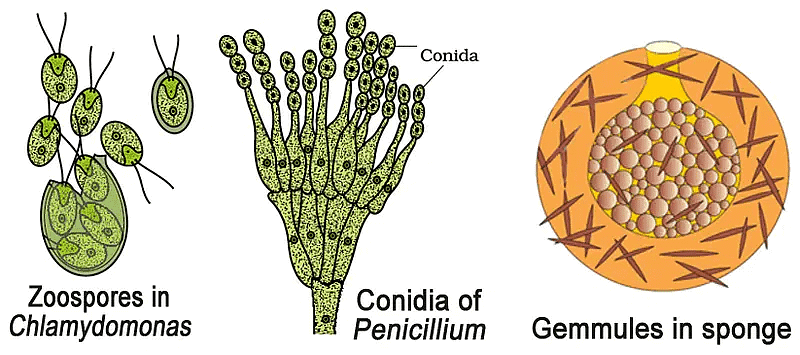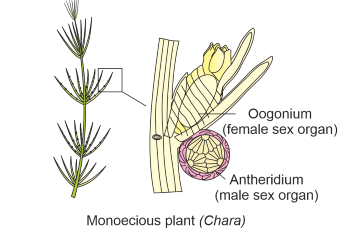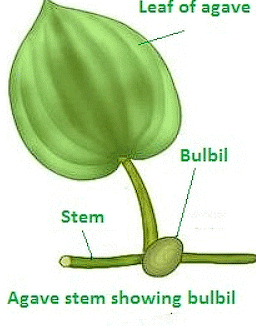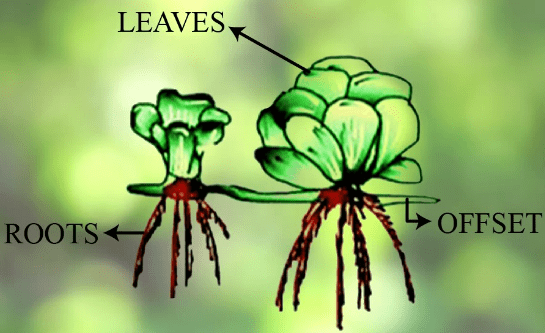Reproduction in Organisms 1 - From Past 28 Years Questions NEET Notes | EduRev
Q1: Identify the asexual reproductive structure associated with Penicillium. [ NEET 2022]
(a) Buds
(b) Zoospores
(c) Conidia
(d) Gemmules
Ans. (c)
The asexual reproductive structure associated with Penicillium is conidia.
- Penicillium is a fungus that reproduces both sexually and asexually. The asexual mode of reproduction in Penicillium involves the production of conidia, which are a type of spore. Conidia are produced on specialized structures called conidiophores, and they are dispersed by wind, water, or other means.
- Buds are a form of asexual reproduction seen in some animals and plants, where a new individual develops as an outgrowth from the parent.
- Zoospores are motile spores that are found in some algae, fungi, and protozoa.
- Gemmules are a type of asexual reproductive structure found in some sponges, where a cluster of cells form a resistant capsule that can grow into a new individual under favorable conditions.
Note: In 2023, there were no questions asked from this chapter.
Q2: Which of the following plants is monoecious? [ NEET 2021]
(a) Marchantia polymorpha
(b) Cycas circinalis
(c) Carica papaya
(d) Chara
Ans. (d)

- The plant that is monoecious among the given options is Chara, which is a member of the Charophyta division of algae.
- Chara is an alga with monoecious condition. It has male sex organ antheridium and female sex organ oogonium at the same node.
- Marchantia polymorpha, on the other hand, is a liverwort that is dioecious, meaning it has separate male and female plants.
- Cycas circinalis is a gymnosperm that is also dioecious, with separate male and female trees.
- Carica papaya is a flowering plant that is monoecious but has separate male and female flowers on the same plant.
Q3: Vegetative propagule in Agave is as: [ NEET 2020]
(a) Rhizome
(b) Bulbil
(c) Offset
(d) Eye
Ans. (b)

A bulbil, which is a type of vegetative propagule found in the Agave plant. Bulbils in Agave are floral buds that have been altered and grow on the flowering axis. These bulbils remain connected to the floral axis and eventually sprout into new plants. Therefore, the accurate response is 'Bulbil'.
Q4: In some plants, the female gamete develops into embryo without fertilisation. This phenomenon known as [ NEET 2019]
(a) Parthenogenesis
(b) Autogamy
(c) Parthenocarpy
(d) Syngamy
Ans. (a)
- Parthenogenesis is a form of asexual reproduction that occurs in certain organisms such as some insects, fish, amphibians, and reptiles.
- In this process, the female produces an egg that undergoes mitosis to form an embryo without fertilization by a male gamete.
- The offspring produced through parthenogenesis are clones of their mother and are genetically identical to her.
Q5: Offsets are produced by [ NEET 2018]
(a) Meiotic divisions
(b) Mitotic divisions
(c) Parthenocarpy
(d) Parthenogenesis
Ans. (b)
- Offset is a vegetative part of a plant formed by mitosis.

- Meiotic division occurs in reproductive organs during formation of gametes.
- Parthenogenesis is the formation of embryo from ovum or egg without fertilisation.
- Parthenocarpy is the fruit formed without fertilisation.
Q6: Which of the following flowers only once in its lifetime? [ NEET 2018]
(a) Bamboo Species
(b) Jackfruit
(c) Mango
(d) Papaya
Ans. (a)
Certain bamboo species are monocarpic, i.e., flower generally only once in their lifetime (after 50-100 years). Other plants (jackfruit, mango and papaya) are polycarpic, i.e., produce flowers and its many times during their lifetime.
Q7: Which one of the following statements is not correct? [NEET 2016]
(a) Offspring produced by the asexual reproduction are called clone.
(b) Microscopic, motile, asexual reproductive structures are called zoospores.
(c) In potato, banana and ginger, the plantlets arise from the internodes present in the modified stem.
(d) Water hyacinth, growing in the standing water, drains oxygen from water that leads to the death of fishes.
Ans. (c)
The statement that is not correct is option (c), which states that in potato, banana, and ginger, the plantlets arise from the internodes present in the modified stem.
In reality, plantlets arise from different parts in these three plants:
- In potato, plantlets arise from the axillary buds located in the eyes of the stem tuber, which is a modified underground stem.
- In banana, plantlets arise from the modified stem called a sucker.
- In ginger, new buds arise from the nodal area of the horizontal, branched rhizomes.
Therefore, option (c) is incorrect.
Option (a) is correct, as offspring produced by asexual reproduction are genetically identical to the parent and are called clones.
Option (b) is also correct, as zoospores are a type of microscopic, motile, asexual reproductive structures found in some algae, fungi, and protozoa.
Option (d) is also correct, as water hyacinth is an invasive aquatic plant that can cause the depletion of oxygen in water bodies, leading to the death of fish and other aquatic animals.
Q8: Which one of the following generates new genetic combinations leading to variation? [NEET 2016]
(a) Vegetative reproduction
(b) Parthenogenesis
(c) Sexual reproduction
(d) Nucellar polyembryony
Ans. (c)
- Sexual reproduction involves formation and fusion of male and female gametes.
- Gamete formation is accomplished through meiotic cell division which involves crossing over between non-sister chromatids of homologous chromosomes leading to new genetic recombination in gametes.
- Random fusion of these male and female gametes lead to the genetic variability in the offspring which although resemble their parents but also exhibit new traits of their own.
Q9: Match column I with column II and select correct option using the codes given below. [NEET 2016]
(a) A-(iv), B-(iii), C-(i), D-(ii)
(b) A-(ii), B-(i), C-(iv), D-(iii)
(c) A-(i), B-(ii). C-(iv), D-(iii)
(d) A-(iii), B-(i), C-(iv), D-(ii)
Ans. (d)
Q10: Seed formation without fertilization in flowering plants involves the process of: [ NEET 2016]
(a) Sporulation
(b) Budding
(c) Somatic hybridization
(d) Apomixis
Ans. (d)
Apomixis (asexual seed formation) is the result of a plant gaining the ability to bypass the most fundamental aspects of sexual reproduction: meiosis and fertilization.
Apomixis
Without the need for male fertilization, the resulting seed germinates a plant that develops as a maternal clone.
|
78 videos|280 docs|174 tests
|
FAQs on Reproduction in Organisms 1 - From Past 28 Years Questions NEET Notes - EduRev
| 1. What is the process of reproduction in organisms? |  |
| 2. What are the different modes of reproduction in organisms? |  |
| 3. How does asexual reproduction occur in organisms? |  |
| 4. What is the significance of sexual reproduction in organisms? |  |
| 5. How does fertilization occur in organisms? |  |




























